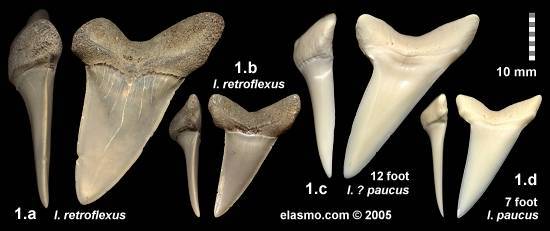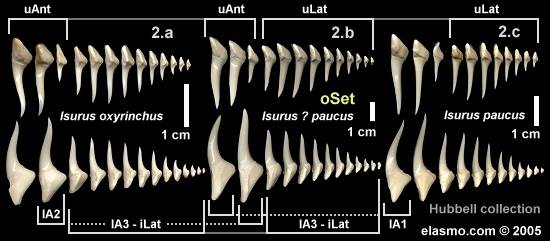|
|
Within days of the mako slide-show going public, the study set of Longfin (3.7m Isurus paucus) teeth was challenged — Anthony Chappell argued it represented the dentition of a large Shortfin (Isurus oxyrinchus). Rather than leave questionable material on the website, it was removed, and within a week replaced with a tooth-set of a smaller (2.2m) Longfin. The identification of the original tooth-set set (referred to below as the oSet) lacks universal consensus.
Initial Identification
On May 5, 1999, a large (estimate 3.7m) female mako was caught and identified using the standard identification keys (below). Deemed to be a Longfin, the dentition was obtained by Gordon Hubbell and included in the original slide-show. At the time this specimen was caught there were a number of recognized identification keys (iKeys) for distinguishing makos. I haven't found the origin of each, but they had been included by Dodrill & Gilmore (1979) and Compagno (1984):
| Characteristic | I. oxyrinchus | I. paucus |
| Snout: | usually acutely pointed | narrowly to bluntly pointed |
| Pectoral fins: | shorter than head (narrow-tipped in young, pointed in adults | same length as head or broad-tipped in young & adults |
| Anal fin origin: | under midbase of 2nd dorsal fin | under insertion point of 2nd dorsal fin |
| Coloration: | underside of snout & mouth white | underside of mouth & snout dusky |
| Eyes | moderately large | relatively large |
| Anterior teeth: | teeth recurved lingually; tips curved distally | teeth relatively straight, tips not reversed |
| uA1: | incomplete cutting edge | complete cutting edge |
The Dodrill & Gilmore paper described a 3.2 m (estim) Longfin and went on to contrast it with a similarly-sized Shortfin. Amongst other things (particularly coloration), they noted that the usefulness of 'pectoral fin length' was less reliable as the individual got larger. In their specimen, the uA3 was triangular in shape and the A3-L1 diastema reduced. Other tooth features remained consistent with smaller individuals — the Longfin teeth were broader and thinner. The identification of the oSet would have considered the above iKeys.
Current Identification Keys
In the last twenty years, the iKey-set has become more refined. Summarizing and combining the diagnostic characteristics listed by Compagno (2001) and Ebert (2001) provides a longer and hopefully better iKey list.
| Characteristic | I. oxyrinchus | I. paucus |
| Body: | Robust compared to Longfin | Relatively slender |
| Coloration: | Dorsal bright blue, underside of mouth & snout white in adults | Dorsal dark blue, underside of mouth & snout dusky in adults |
| Snout: | usually acutely pointed | narrowly to bluntly pointed |
| Mouth: | U-shaped | Parabolic |
| Eyes: | relatively small | relatively large |
| Pectoral fins: | shorter than head (narrow-tipped in young, pointed in adults) | same length as head or longer, broader in young |
| First dorsal fin: | more angular and narrowly rounded in adults | apex broadly rounded |
| Pelvic fin anterior: | Noticeably less than posterior margin | Nearly equal posterior margin |
| Anal fin origin: | Under midbase of second dorsal fin | Slightly posterior to insertion of 2nd dorsal fin |
| Flesh: | firm-bodied - desirable | mushy - poor quality |
| Anterior teeth: | Narrower, cusps flexed, tips reversed | Broader, teeth broad & relatively straight, tips not reversed |
| uA1: | incomplete cutting edge | complete cutting edge |
| uA3 (intermed.): | curved, oblique distally hooked | straight or slightly hooked cusps |
During these intervening years, it's obvious that more has become known about the Longfin and its differences with the Shortfin. However, some of the characteristics become ontogenetically qualified such as the coloration, pectorals and dorsal fin. I have found no reference where large makos (>3.5m) have been compared/contrasted and Henry Mollet (pers com Aug 2005) suspects it hasn't been done.
Chappell Observations
An amateur by definition, Anthony Chappell challenged the identification of the oSet. Twenty years of obsession with makos created a mind-set of its dentition-design. In seeing elasmo.com images, he found them in conflict with his personal iKeys. The specificity of his observations (see: Chappell iKeys) sufficiently raised a 'red flag' leading to this webpage. Applying Anthony's iKeys to the oSet certainly could suggest it be a Shortfin as would be another dentition from a 4.2m female from Florida1.
Gordon (pers com Aug 2005) responded with the following observations:
| "Makos under 10' in total length are easy to tell apart from the tooth structure and length of pectoral fin. However when the female Longfins grow larger than 10', the pectoral fin shortens up and approximates the Shortfin's, and the tooth structure changes and looks very much like a Shortfin. There seems to be some variation in the tooth structure of large Longfins - probably more so than I have seem in Shortfins. I remember receiving the head from a Longfin several years ago that was dark gray with large eyes and very little white under the chin. When I prepared the jaw, I found that the teeth were identical to a Shortfin. I have talked this problem over with Jose Castro, and he brought up the possibility of hybridization between the two, but we later dismissed this as being unlikely based mostly upon their evolutionary history." |
In a follow-up response (pers com Aug 2005) he went on to note:
The weakness and strength of Anthony's arguments are based on the diagnostic value of the jaw and tooth-design. His iKeys include those of others and ones he added. His collection of five paucus dentitions is very good, but based on tooth size; they likely represent individuals that do not exceed the 3.5m threshold. The question (and I don't have the answer) is does the jaw and tooth-set design override other morphological iKeys, particularly in large makos that haven't been fully contrasted? The full scope of this question is the basis for the Isurus ? paucus caption of that page.
Convergence
In contrast to the Shortfin, the Longfin is poorly known. The distinct difference in tooth designs, at least in smaller individuals, suggests different food diets. The awl-like anteriors of the Shortfin are much better designed for grasping than the broader and flatter cusps of the Longfin which would better serve a cutting function. Compagno (2001) notes that the variation in body-design would suggest a slower less active shark. However, as the sharks cross that 3.5m threshold, the two species may focus on a similar prey-set. As Gordon notes, the two begin to look more and more alike, including their dentition designs.
In the fossil record, the Miocene counterpart of the Longfin is Isurus retroflexus (Agassiz, 1843) thought by some to be a chronospecies of I. paucus. Large teeth of the fossil taxa maintain the flattened cusps. These teeth are not particularly common, so an ontogenetic series is currently unknown to the author.
The accompanying image illustrates a range of sizes known from Lee Creek2 which are compared with similarly positioned (second upper anterior) teeth in the presented slides.
 Figure 1c represents the uA2 of the questioned oSet. It is appreciably thicker than the other specimens and more awl-like — characteristics of a Shortfin. The smaller teeth remain similar despite a 17-20 million-year separation. The larger fossil (fig 1a) would tend to demonstrate that there was less convergence with I. retroflexus, suggesting that the prey-set of larger Longfin-types was different during the Miocene.
Figure 1c represents the uA2 of the questioned oSet. It is appreciably thicker than the other specimens and more awl-like — characteristics of a Shortfin. The smaller teeth remain similar despite a 17-20 million-year separation. The larger fossil (fig 1a) would tend to demonstrate that there was less convergence with I. retroflexus, suggesting that the prey-set of larger Longfin-types was different during the Miocene.
As Chappell argued, tooth characteristics of the oSet point to I. oxyrinchus. Revisiting the underlying images, I noticed that the oSet also provides data for the concept of convergence. The following image views the three included tooth-sets from a lateral perspective. (Each has been resized to provide a uniform dimension.)

It is interesting to note that the oSet (center) actually reflects characteristics of both I. oxyrinchus (left) and I. paucus (right). The anterior teeth (basis of most of Chappell's arguments), except for the lower first are indeed Shortfin-like. However, the lingual recurvature of the teeth emanating from the upper lateral-hollow are Longfin-like. The lower laterals are more upright, as seen in the Shortfin dentition.
What seems apparent to this author is that convergence takes place between the modern taxa, but it hasn't been sufficiently studied to provide an ontogenetically-sensitive set of identification keys. This is an open page, so additional thoughts and observations would be appreciated.
Footnotes
1. According to Henry Mollet (pers. com. Aug, 2005) if this were to be a Shortfin, it would be the largest ever reported. See: Large Shortfins and Summary of Longfin Makos.
2. The Ken and Pat Young collection of Isurus retroflexus teeth served as the basis for the taxon. All employed specimens were collected by them from Pungo River Formation (Burdigelian, Early Miocene) tailings or reject at the phosphate mine in Aurora, NC. This tooth collection likely represents the largest data-set of these fossil teeth available for study.